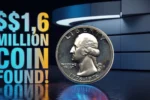How to Identify the Rare 1942/1 Mercury Dime That Could Make You $95,000 Richer: Among the many treasures hidden in coin collections, one particular coin has fascinated collectors for decades—the rare 1942/1 Mercury Dime. With examples fetching up to $95,000 at auction, this small silver coin might just be the jackpot hiding in your spare change, old coin albums, or inherited coin jars.
Whether you’re a seasoned collector or a curious beginner, knowing how to spot this rare dime could be financially life-changing. Here’s a simple guide to identifying the 1942/1 Mercury Dime, understanding why it’s valuable, and what you should do if you think you’ve found one.
Why Is the 1942/1 Mercury Dime So Valuable?
The 1942/1 Mercury Dime is an overdate error coin, meaning that the die used to strike the coin was first engraved with a “1941” date and then mistakenly re-engraved with “1942” on top of it. This mistake was never intended to be released into circulation but managed to slip past quality control.
There are two types of 1942/1 overdate dimes:
-
1942/1 (Philadelphia Mint)
-
1942/1-D (Denver Mint)
Both varieties are rare, but the Philadelphia version is slightly more valuable, especially in high-grade condition. The rarity, combined with historical significance and collector demand, drives prices sky-high.
How to Identify the 1942/1 Mercury Dime
Spotting a 1942/1 Mercury Dime requires close observation. Here’s what you need to look for:
🔍 Key Identification Features
| Feature | Description |
|---|---|
| Date | Look closely at the “2” in the date. You should see the bottom curve of a “1” peeking out underneath it. |
| Magnification | Use a 10x jeweler’s loupe or a digital microscope to inspect the date more clearly. |
| Mint Mark | For the 1942/1-D, check for a small “D” to the left of the torch on the reverse. No mint mark means it’s from Philadelphia. |
| Overall Condition | Even worn examples can be valuable, but uncirculated or high-grade coins command the highest prices. |
Value of the 1942/1 Mercury Dime
The value of the coin depends on its condition and whether it’s from the Philadelphia or Denver mint.
💰 Estimated Value by Condition
| Condition | 1942/1 Value (P) | 1942/1-D Value |
|---|---|---|
| Good (G-4) | $400 | $250 |
| Fine (F-12) | $700 | $400 |
| Extremely Fine (EF-40) | $2,000 | $1,000 |
| Mint State (MS-63) | $10,000+ | $6,000+ |
| MS-65 Full Bands | $95,000+ | $50,000+ |
Note: “Full Bands” refers to sharp detail in the bands on the torch, a feature that boosts value significantly.
Where to Look for One
You might find a 1942/1 Mercury Dime in:
-
Old family coin collections
-
Antique stores
-
Estate sales
-
Coin dealer junk bins
-
Coin rolls from the bank (rare, but possible)
-
Online marketplaces (always verify authenticity)
What to Do If You Think You Found One
-
Verify the Date Carefully: Use magnification to look for the overdate.
-
Check for Authenticity: Compare with known reference photos online or in coin guides.
-
Get It Appraised: Submit it to a reputable grading service like PCGS or NGC.
-
Avoid Cleaning It: Cleaning coins can ruin their value. Always leave them in “as-is” condition.
-
Consider Selling: Once authenticated and graded, you can sell through a coin auction house or online platform.
Final Thoughts
Finding a 1942/1 Mercury Dime is like discovering a hidden treasure. These tiny silver coins are reminders of America’s coinage history—and a prime example of how a minting mistake can turn into a collector’s goldmine.
If you’re a casual collector or someone cleaning out a family attic, keep an eye out for this coin. The overdate is visible to the naked eye with the right tools, and it could mean a payout worth tens of thousands of dollars.
So next time you’re flipping through old dimes, don’t just look at the shine—check the date carefully. You might just be holding a rare gem that could change your fortune.
FAQs About the 1942/1 Mercury Dime
Is the 1942/1 Mercury Dime silver?
Yes. Like all Mercury Dimes from 1916 to 1945, it’s made of 90% silver and 10% copper.
How many 1942/1 dimes exist?
Estimates suggest less than 10,000 authentic examples survive today, especially in high grades.
Can I find this dime in circulation today?
It’s extremely unlikely due to its value, but it’s not impossible—some have turned up in old coin jars and estate finds.
What does “Full Bands” mean?
It refers to the horizontal lines on the torch on the reverse of the dime. If these lines are fully visible and not worn, the coin is said to have “Full Bands,” which increases its value significantly.




